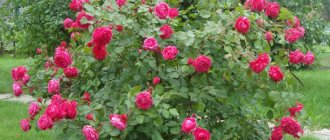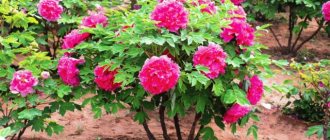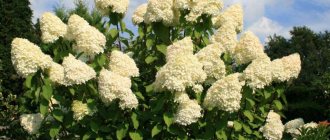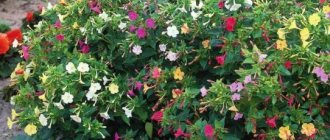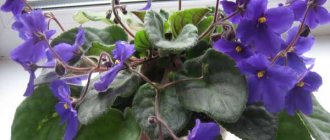An ideal flowerbed can only be considered one that remains blooming throughout the entire summer period. Its creation is not an easy task. Indeed, in this case, the trick is not only in proper planting, but also in the correct selection of partner flowers. For example, you can start with primroses, complement them with flowers that bloom in May, and be sure to plant herbaceous perennials nearby, which will create a perfectly green background from April to October... Or you can do it easier by buying rose seedlings that bloom all summer. If you don’t know what varieties we are talking about, we can easily fill this gap.
It must be admitted that roses that bloom all summer are especially popular among summer residents and owners of country houses, which is why breeders rely on them. Of course, because the pink aroma that dominates the area captivates and beckons, and the contemplation of the blooming “queens” gives unimaginable aesthetic pleasure even to a passerby - not to mention the owner of such a magnificent flower garden.
Types and classification of winter-hardy roses
There is a modern classification that divides all frost-resistant varieties of roses into 3 groups:
- Absolutely winter-hardy flowers are also in an upright position in winter, withstanding the lowest temperatures and do not require special care;
- winter-hardy roses are also vertically positioned during wintering, but in severe frosts there is a tendency to freeze; average degree of stability do not require shelter in mild winters and freeze only to the level of snow, so they need to be bent.
The most winter-hardy roses - video
The highest frost resistance is present in park roses:
winter-hardy varieties are represented by William Shakespeare, Westerland and others.
They are ideal for growing in the central zone of the country, in particular in the Moscow region. BEAUTIFUL VARIETIES OF ROSES!
Rose Versilia Climbing rose Caesar Rose Pierre de Ronsard
Artificially bred roses in the form of Canadian hybrids, which are able to survive at temperatures of -45 degrees below zero without damage, can easily compete with them. They are also suitable for the northern regions, the Urals and Siberia.
What are miniature roses?
The homeland of dwarf roses is China, because it was there that the first attempts were made to create a mini-version of the flower that would bloom all year round and be more hardy (we all know that the rose is a rather capricious flower). In the late 1890s, Europeans also began experimenting with creating highly productive dwarf versions of roses.
Reference! The founder of the first modern improved varieties of miniature roses is the famous variety Rouletii.
Since gardeners became interested in breeding mini-roses, breeders began to annually produce several hundred different varieties and hybrids of dwarf flowers. All of them are similar in the compact habit of the bush, but differ in the color of the petals and the structure of the flowers: they are simple and double, large and small, cup-shaped and goblet-shaped. Most varieties of miniature roses are suitable for both garden and indoor growing.
The value of dwarf roses:
- Dwarf roses are similar in height to groundcover roses. However, they are distinguished by the peculiarity of the structure of the shoots - in the mini version they do not fall down or spread along the ground, but grow only upward, creating a beautiful lush bush;
- short shoots are still very strong and strong. They can withstand a thick layer of dense foliage and the weight of dozens of voluminous inflorescences well;
- small buds have a variety of one- and two-color petals;
- in many varieties, the color scheme of flowers changes as the bud blooms and ages;
- the flowers of miniature versions are most often collected in large clusters consisting of 5-20 buds;
- Dwarf roses bloom in waves from spring to late autumn. With proper care at home, buds form all year round.
Fact!
Miniature roses are the same garden roses, only in a smaller copy.
Dwarf roses are a self-sufficient and valuable element of the garden. And although they are not so spectacular when planted alone, and are lost in large flower arrangements, they look great in a border design (miniature flowers are also called “border flowers”), in the foreground of a rock garden and rose garden. Low-growing varieties, the bushes of which barely reach 20 cm in height, are excellent for container growing. Lush flowering caps look impressive in hanging flowerpots, as well as in vases and pots placed on the terrace, porch or at the entrance to the house. These wonderful flowers will miraculously enhance your home space. In addition, border roses look gorgeous in a cut bouquet.
The most winter-hardy and frost-resistant varieties of roses
Almost all winter-hardy roses are easy to care for, hardy and have a long flowering period. For this reason, they are recommended to be grown by beginning rose growers. Below are the best varieties of frost-resistant roses.
The Fairy (Fairy Rose)
The Fairy rose variety was developed in 1932. Sheer charm. Today it is considered the most popular all over the world precisely because of its easy care and constant, luxurious flowering with many small pink roses. There can be from 10 to 40 flowers on one branch. The branches are thin and graceful. There is the ability to self-cleanse.
Photo of Fairy rose
Lilac rain
Belongs to the scrubs. The “Lilac Rain” rose withstands winters even with virtually no snow and very low temperatures. It has beautiful buds of a pastel lilac shade. Terry petals. It blooms in two periods. An adult shrub grows up to 60–120 cm.
Heidetraum
An ideal choice for a beginner gardener with no experience. The rose variety “Heidetraum” is a ground cover, does not require complex care, has remarkable flowering and high immunity. The buds are colored deep pink, the structure of the petals is terry and there is a small speck of white on the surface.
Sunny Rose (Sunny Rose)
Representative of the “bush roses” group. The shrub is decorated with buds of a sunny yellow hue. When in bloom, they form a real carpet of flowers. The Rose Sunny shrub is capable of occupying a whole 1 m2 for itself. It blooms for a long time and almost without interruption. Inflorescences-tassels are formed by collected buds of 12 pieces. In bright sunlight they tend to fade, becoming creamy in color.
Photo of rose Sunny
Rating of ground cover roses
When compiling our rating, our team familiarized itself with dozens of varieties of these wonderful plants and the history of their selection. When selecting nominees, the peculiarities of planting and caring for them, reviews from gardeners, and assessments of breeders were taken into account. Particular attention was paid to the following properties:
- The size and number of flowers on the stem;
- The nature of the stem (creeping or drooping);
- Ease of plant care;
- The presence of immunity;
- Frost resistance level;
- Growth rate.
The classification of varieties within a group is based on the difference in the types of shoots, plant height, and width of the area covered. Shoots are long creeping, arched falling, widely branching and short creeping. The bushes grow up to 35 – 250 cm in height. Their working width, depending on the variety, can be up to one and a half meters and from one and a half meters or more.
For ease of understanding the information, we have divided the rating nominees into two groups. The first presents the 7 best varieties of ground cover roses. The second group of five varieties included the most frost-resistant hybrids.
The best soil for plants
Winter-hardy varieties of climbing roses
Quite often, garden owners purchase climbing varieties of frost-resistant roses. The reason is the long, twisting and flexible stems. They can be positioned vertically or at an angle using support and garters. Often these roses are used to decorate arches and arbors, and are used to disguise defects in a structure (for example, they cover cracks in the walls of old houses, etc.).
The best varieties of climbing roses for Siberia and the basic rules for planting them - video
Rosarium Uetersen
A plant with large flowers. Brought out in the 70s of the last century. The rose variety “Rosarium Jutersen” did not immediately gain popularity. Only at the beginning of the century they began to actively cultivate it. The size of the buds is up to 15 cm in diameter. The palette is limited to “classic” pink. The crown is luxurious, with dense foliage. Suitable for the southern part of the garden plot.
Santana
An adult rose shrub "Santana" grows up to 3 m. The buds are arranged either singly or in clusters. Diameter 12 cm. Bright blooming with rich red flowers immediately attracts attention. The flowering period of this winter-hardy variety is long. To plant one specimen, a space measuring 50 x 50 cm is required. It is planted mainly in the southern territory in spring or autumn.
Golden Showers
Another representative of unusual yellow roses. Flowers with double petals are incredibly fragrant. "Golden Showers" is the most frost-resistant rose of all the vines.
Flowering lasts until the last days of autumn. Blooms several times a year. The height of an adult plant reaches 2 m. It is undemanding to the composition of the soil. Has good immunity from diseases.
On a note!
Climbing roses bloom throughout the summer season. They differ in color and size of buds. Terryness is also present to varying degrees. Among the representatives of climbing roses there are plants with small flowers and large ones.
"King Arthur"
It is considered one of the best varieties of park roses. The plant is a strong, erect bush 70–85 centimeters high. Double flowers with a diameter of 8–12 centimeters usually appear one at a time. The center is soft peach, and closer to the edges there are pale pink petals.
The best flowering results for the King Arthur rose can be achieved if it is planted in well-drained soil and regularly fed with fertilizers. In the southern regions, it can delight with buds from summer until frost without interruption.
Winter-hardy roses that bloom all summer
Roses that bloom throughout the summer begin to grow actively at the end of May. They can also bloom in autumn. They come in wrinkled, polyanthus and park varieties. Particularly long flowering is typical for bush representatives.
THE BEST VARIETIES OF ROSES THAT BLOW ALL SUMMER - video
Ballerina (Ballerina)
Ballerina, it can be described in two words: “persistent”, “blooming”. It blooms around mid-June and finishes blooming by November. It can withstand low temperatures, drought, heat, rain and even shade.
She has excellent immunity to various diseases and insect pests. For its merits, “Ballerina” received the title of best scrub rose (among the classics).
Rose Ballerina - photo of flowers
Polka (Polka)
It is distinguished by large flowers, up to 15 cm. Many rose growers agree on the beautiful light peach color. Sometimes the flowers have a coral, more saturated color. The height of the bush is 3 m, not higher. The winter-hardy rose "Polka" perfectly withstands precipitation, bad weather and, of course, winter.
Don Juan
Don Juan is an easy-to-care and unpretentious representative of the “uncovered rose varieties” group. Feels good both during periods of rain and frost. It does not need additional insulation even in the harshest conditions. Also suitable for beginners in growing roses.
Winter-hardy roses that bloom all summer are an excellent option for any garden plot, both with and without shelter.
Brief characteristics of varieties
| number | Variety | Height, color of petals, number of buds in inflorescence |
| 1 | Hello | Height - 50 cm, petals are dark red, turning into cherry, in an inflorescence of 6-10 buds. |
| 2 | Swany | Height - 80 cm, white petals, up to 20 buds in an inflorescence. |
| 3 | Ahtiar | Height - 150 cm, white petals, 5-8 buds per inflorescence. |
| 4 | Nadia Meillandecor | Height - 50 cm, petals are milky, cream or yellow, 3-5 buds per inflorescence. |
| 5 | Les Quatre Saisons Meilland | Height -80 cm, deep pink petals, 10-15 buds per inflorescence. |
| 6 | Ballerina | Height - 150 cm, pink petals, inflorescences from 15 to 100 buds. |
| 7 | Amber Sun | Height - 100 cm, petals are creamy-yellow, 5-8 buds per inflorescence. |
| 8 | The Fairy | Height - 60 cm, petals are pale pink, 10-30 buds per inflorescence. |
| 9 | Rody | Height - 65 cm, inflorescences have 3-12 buds of red-strawberry color. |
| 10 | Heidetraum | Height - 40 cm, deep pink petals, 10-20 buds per inflorescence. |
| 11 | Snowfield | Height - 50 cm, white petals, 3-5 buds per inflorescence. |
Varieties of winter-hardy roses for the Moscow region
As noted above, park roses and winter-hardy varieties are suitable for the Moscow region.
The following points need to be taken into account:
- the variety must be resistant to climate change;
- high immunity will help resist pests and diseases.
Roses wintering in the Moscow region without shelter - video
Since daylight hours are short for more than half a year in these climatic conditions, preference should be given to varieties that do not require a lot of light daily.
INTERESTING!
The best varieties of roses for the Moscow region
Charles Austin
A modern English species, named after its creator, a famous breeder. The uniqueness lies in the color and shape of the buds. As the bud grows, it changes color from delicate to bright orange. There may be several different flowers on the shoot, which is also surprising. Up to 10 cm in diameter. They are cup-shaped. The variety also has rich, glossy foliage.
Rose variety Charles Austin - photo of flowers
The shrub grows up to 1.50 m in height. However, it is located quite compactly on the site. Rose "Charles Austin" blooms in early March. In order for the variety to bloom again, prune and feed. Another feature is the aroma, similar to the smell of fruit.
IT IS IMPORTANT TO KNOW!
Why do roses get sick?
Albe
Representative of wrinkled roses, medium height. Particularly tall specimens grow up to 2 m. The flowers are 8 cm in diameter. They exude a delicate, exquisite aroma. Planted both separately and in compositions. Either way it looks great.
The buds of the Albe rose are white, and with prolonged and bright sunshine they acquire a creamy hue. The difference lies in the foliage. The leaves are almond-shaped, with a smooth surface, rich green in color. It blooms from mid-June, for about a month.
Flamentanz
One of the amazing varieties known to every gardener. Based on reviews and descriptions, it can grow all over the world, in any climate. In addition, it reproduces quickly, which may be important for some rose growers. The bright red buds of the Flamentanz variety stand out effectively against the background of the lush green leaves. The stems are very long - up to 5 m. The inflorescence consists of 15 flowers. Overwinters without shelter. An open place protected from winds is required.
Which ground cover plants are best?
Our team did a great job selecting nominees for the rating. Many ground cover roses have been studied and their characteristics described. Their frost resistance and susceptibility to disease were compared. Customer reviews were analyzed. Thus, only the best plant varieties made it into the TOP. For those who are undecided, we suggest considering a mini rating of the best of the best nominees.
- Purple Rain. German hybrid – that’s what this wonderful hybrid is called and looks like. Many lilac roses cover the creeping branches. It survives frost easily. Disease resistance is average.
- Orfeo. Dutch hybrid. Vigorous specimens perform well in vertical landscape design. Large flowers cover the shoots abundantly, hiding all the imperfections of their support. An excellent option for hedges, decorating gazebos and house walls.
- Rosarium Utersen. Another Climber, tall, with large and lush flowers that bloom periodically. Drapes walls, fences, pergolas and gazebos, creating coziness everywhere and delighting the eye with its beauty.
- Super Excelza. Another German hybrid of excellent quality from the Kordes company. Also a Climber, which works well in vertical compositions. It has proven itself well as a free-standing ground cover bush and as part of horizontal compositions.
The editors of the site hope that our review will help beginning rose growers find their own variety of ground cover rose, decorate their garden, yard, or summer cottage with it, and enjoy the beauty and abundance of these wonderful flowers for a long time.
Canadian varieties of roses are winter-hardy
Canadian ground cover winter-hardy roses were obtained by combining the rugosa rose and representatives of Cordes. The birthplace of selection is Canada.
Canadian roses: advantages and best varieties - video
Queen Elizabeth
A touching plant with delicate petals, light pink color. Petals are semi-double. The brush contains up to 15 colors. Should be protected from direct sunlight to prevent color fading.
Every 6 years, rejuvenating pruning is required, when the shoots are cut off to the very root. According to gardeners, the Queen Elizabeth rose is a rather unpretentious flower, but does not like a too humid climate.
Jens Munk
Of all Canadian roses it has the strongest root and stem system. This allows the plant to grow freely up to 2 m in height. The flowers are small, up to 7 cm in diameter. It has a persistent aroma and elegant shape.
JP Connell (JP Connell)
Found in the Explorer collectibles. This is a yellow rose with a hint of lemon. There are no large brushes. But in the very center of the flowers there are bright red stamens, which are simply impossible not to notice. Terry petals. If the crown is not trimmed from time to time, it quickly grows overgrown. Blooms in waves. Disadvantages include susceptibility to black spot in humid climates. "JP Connell" is considered winter-hardy, but, according to reviews from flower growers, it still needs shelter for the winter.
Leonardo da Vinci (Leonardo da Vinci)
Belongs to floribundas. Blooms luxuriously, with many bright pink flowers. The flowers are flat and double. This variety smells pleasantly of the “classic” scent of the Rose family. Looks aristocratic. Rose "Leonardo da Vinci" is not susceptible to powdery mildew or rust due to the development of resistance to pathogens.
Rosa Leonardo da Vinci - photo
On a note!
Canadian roses can withstand temperatures down to -40 degrees below zero.
Floribunda
This class of varieties has other names that you may have heard: flowerbed roses, roses with inflorescences, hybrid polyanthas. This group includes plants that occupy an intermediate position between hybrid tea and polyanthus roses. This includes tall, medium-sized and border roses, characterized by bouquet flowering and impressive bush size. The aroma of floribunda roses is almost completely absent.
Disneyland
The flowers are large (10-12 cm in diameter), medium-double, orange-pink in color. Bush up to 120 cm high, well branched, vertical. The foliage is dark green and glossy. Tolerates frosts down to –20°C and is resistant to many diseases.
Twiggy's Rose
Many are attracted by the unusual color of the flowers of this rose: from apricot-coral to creamy white. The height of the bush is 120 cm, width is 100 cm, so the Twiggy rose looks great in hedges, group plantings, and is irreplaceable in mixborders. Has a pleasant moderate aroma.
Leonardo da Vinci
The flowers of this variety have a rich pink color and a dense double texture. The bush is compact: not wide (up to 60 cm), but relatively tall (up to 110 cm). These roses are not afraid of temperature changes and bloom profusely. They look impressive in the garden no matter how they are planted.
Frost-resistant rose varieties for Siberia
Siberia (and the Urals as well) is characterized by a difficult climate, which does not offer favorable conditions for gardening. There are not many warm days here, summers are short, and winters are long and frosty. Among the winter-hardy roses for Siberia, the following varieties can be distinguished.
Westerland
Represents Cordes roses. This is a relatively young species that quickly became in demand. Tall - up to 2 m in height. The bush of the Westerland rose variety is wide, approximately 1.5 m in diameter. The flowers are medium in size, up to 11 cm. They have a rich aroma. During the growth process they change color from bright to light. So, rich apricot shades become soft orange or even pink. This feature can be used for landscape design.
William Shakespeare 2000 (William Shakespeare 200)
The leader among roses with red flowers. The shrub is lush, medium-sized, up to 120 cm. The diameter of the William Shakespeare 200 rose is approximately 1 m. New shoots bloom in a short time. The brushes are large and last for more than 14 days. The petals are terry, medium in size, up to 10 cm. They have a floral aroma.
Photo of rose variety William Shakespeare
How to choose a ground cover rose
In order not to make a mistake in choosing a rose variety, you need to determine several basic characteristics that will guide buyers. Rose growers are primarily interested in the interior qualities of the variety, i.e. how it will look in the garden. Landscape designers take a somewhat broader view of this. Their task is to eliminate problems in the allocated area, i.e. cover up unsuccessful buildings, fences, and landscape problems with beautiful plants. Let's consider the main criteria.
Growing conditions
Our country is large, there are many climatic zones and they are all different. And almost everywhere there are lovers of growing flowers, including roses. For our gardeners, the most important characteristics will be the frost resistance of the variety, its ability to withstand severe frosts and early spring frosts. Through the efforts of breeders, varieties have been developed that can withstand twenty-degree frosts.
Kordes company specialists were engaged in breeding polyanthus roses for Germany, whose climate is in many ways similar to the weather conditions of our central zone. You can safely choose ground cover roses for the Moscow region from the Cordes collection of hybrids. The most frost-resistant varieties are offered by Canadian breeders. Their collections include varieties of polyanthus roses that can withstand forty-degree frosts.
In addition to resistance to cold, it is very important to know how the rose tolerates prolonged rains. Some varieties begin to rot during this period. This feature is necessarily written down in the characteristics of the variety.
Quality of seedlings
Choose strong seedlings, two to three years old, with smooth, healthy bark. Pay attention to the condition of the roots. They must not be damaged. Be sure to ask what they are offering you, a plant with its own roots or a grafted one, and if grafted, then on what rootstock. Its frost resistance primarily depends on this.
Beginner rose growers should consult an experienced specialist. It is better to buy strong plants from trusted suppliers. An example is the German company Cordes, already mentioned by us. The high quality of its plants is beyond doubt. Dutch, French, and Canadian specialists offer high-quality products.
Fastidiousness in care
The main criteria here are the variety’s resistance to fungal infections: powdery mildew and black spot. These diseases overtake plants in waterlogged soil, rainy climate, i.e. The danger of such an infection arises from dampness. There are no absolutely resistant varieties and there cannot be. Unpretentious roses can also get sick, but much less often than less resistant ones. In addition to diseases, flowers are threatened by pests, for example, spider mites, thrips, etc. Regular and competent treatment of plants is required. This is the only way to keep them healthy and enjoy their beauty.
How to feed beauties
Fertilizing is a necessary process in caring for ground cover roses. Only three feedings will be needed per season. The first is after the leaves bloom. Liquid complex fertilizers or organic matter are perfect here.
The second feeding completes the first wave of flowering, because the plants need to gain strength to set new buds. You can purchase special fertilizers for rose blooms, and if this is not possible, then again add complex nutrients, but in granules. After spreading the fertilizer, thoroughly moisten the soil, and after a few hours, loosen it.
Potassium fertilizers will be used in the fall, completing flowering. Roses will prepare for winter by stocking up on nutrients so that they can grow quickly as the weather warms up.
The best German varieties
German selection is the best that can be recommended for decorating your site. The varieties are so numerous and varied that it would take a long time to talk about them all, but I will tell you about just a few. I recommend you:
- Stadt Rom (low bushes with pinkish-pastel flowers that feel great even in the summer heat);
- Eskimo (white flowers collected in large inflorescences, bushes do not need pruning);
- Larissa (long branches cascading in a beautiful waterfall, pink blooms, very abundant);
- Jazz (low bushes with original flowering - each flower is a different color, from light yellow to dark orange);
- Lipstick (a disease-resistant plant with exotic flowers - the lower part is creamy white, the upper part is dark purple);
- Matador (compact bush with semi-double pink inflorescences).
The varieties bred by German breeders tolerate difficult climatic conditions well, are rarely affected by diseases, and winter well even in harsh winters, but a warm cover will not be superfluous.
Correct fit
Think planting ground cover roses is easy? Of course, there are no particular difficulties, but there are still some secrets, and I will tell you now. The first thing to do is prepare a place for the roses. Please note that they will occupy a large area after they grow; you need to dig up the entire area to a great depth, while simultaneously manually selecting all the weed roots.
After digging, spread a thick layer of mulch - humus or compost. It is better to plant bushes in trenches, the depth of which depends on the size of the root system. What is the ideal time to plant? In warm regions, you can plant ground cover roses in the fall, but if the climate does not spoil you with a warm winter, then it is better to decorate your plot with blooming beauties in the spring, after the snow has melted.
Before planting roses, be sure to dip the roots in a container of warm water. If you purchased the seedlings a long time ago and they have dried out a little, then leave them in the liquid for a day. The next day, carefully inspect each root and remove any dried or rotten ones.
Place the seedling in the prepared trench, straighten the roots, and only now begin to cover it with soil. Do this with your hand, shaking the bush a little so that all the voids between the roots are filled with soil. After filling the trench, lightly compact the soil and water thoroughly.
Pruning: what you need to know
Don't assume that every variety needs pruning. There are some ground cover roses that are strictly not recommended to be pruned, but if you notice that the shoots are starting to grow inward, you can remove them. You also need to start shortening the branches when you plan to grow a compact, lush bush.
Each cut should be treated with garden varnish, and the entire plant should be sprayed with copper sulfate. Also, once every 6-8 years you need to completely cut off the above-ground part - this way you will help your pets rejuvenate. New shoots will begin to grow from the roots - fresh and powerful.

